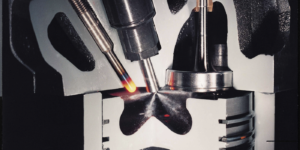If you must advance SOI, you need larger injectors…PERIOD ! That is the whole secret what misinformed public refuses to understand.
Dangerous game
Advancing SOI is dangerous game if you go wild !!! Play with HR ECU remap simulator to see for yourself. Observe what happens with cylinder pressure.
Advancing SOI by 1° seems to have no long-term effects on engine (based on our engine oil analysis).
Discussion with insider
I had an interesting chat with a guy who seem to work for car manufacturers. I wrote the popular phrase, “if you must advance SOI, you need larger injectors”.
Of course, there was an outcry of angry mob how I dare to question the truth. If you filter out the usual bullshit of normals, you may find fascinating information.
The guy said, “it is not entirely correct that SOI changes won’t improve anything. There is a potential to get better economy, and more torque.”
But there is a BUT – how do you measure it? If you cannot measure it, don’t change it. Check out ECU remap simulator, and observe how cylinder pressure increases rapidly.
Fundamental confusion
In the image below, you can see what is inside the Hilda’s ECU.

Check out the third row from the bottom, labeled EOI – that is a value in degrees of CsR where injection ends. It is an angle ATDC.
Old wives stories tell about the perfect EOI around 15° ATDC… as usually, most misunderstandings come from lack of knowledge. As you can see yourself, EOI varies from ~ 10° down to 6.5° at high engine speeds.
Where is the 15° ?
The secret
If everything were so easy as chiptuners try to preach, we would live in a perfect world of clean, high-performance cars.
In reality, everything is linked together and one tiny change results in a domino effect of many changes that may lead into unwanted results.
First, EOI doesn’t matter because it doesn’t move pistons. Optimal combustion process needs to end ~ 2° ATDC where you need max. combustion pressure to move pistons down for maximal engine torque.
Do not change what you cannot measure…PERIOD !!!
Current injection timing is a result of thousands of hours inside the dyno cell where engineers play with various parameters to achieve max. engine torque with optimal balance of fuel consumption, and emissions.
Whatever you do is just a compromise
Let’s talk numbers based on above by picture:
| rpm | SOI | duration | EOI |
| 2000 | 12 | 22.5 | 10.5 |
| 3000 | 17.5 | 25.7 | 8.2 |
| 4000 | 25 | 31.5 | 6.5 |
Now, we add what most do not understand, the mysterious ID.
| rpm | SOI | duration | EOI | ID | burn |
| 2000 | 12 | 22.5 | 10.5 | 5 | 15.5 |
| 3000 | 17.5 | 25.7 | 8.2 | 5 | 13.2 |
| 4000 | 25 | 31.5 | 6.5 | 5 | 11.5 |
We have now a theoretical parameter called “burn” where combustion process starts to fade. There may be something about “the 15° ATDC max. toque” theory.
At 2000 rpm we have max. engine torque with 15.5° of max. burn rate. High engine speeds mystery:
Based on our field logs and experiments, high engine speeds/loads suffer horribly from overheating, and engineers simply reduced engine torque/power to avoid engine damage.
Do not forget, the family cars were not designed for spirited drives but for comfy shopping trips…even those so-called sport cars 😉

Leave a Reply